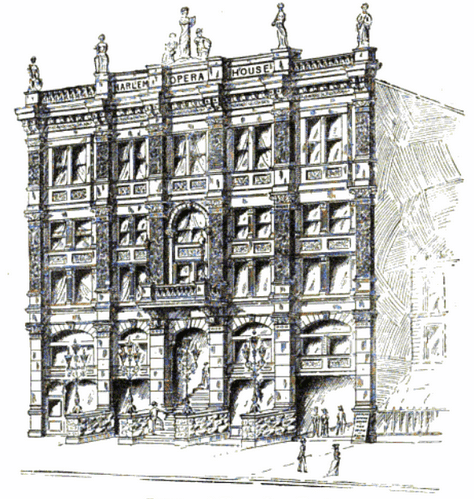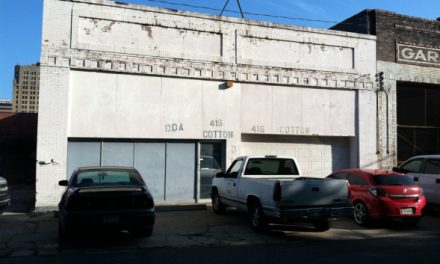For a relatively short span of 40 years, Shreveport had a Grand Opera House. The structure, built in 1888, sat at the corner of Texas Street and Edwards Street at the site of the 400 Texas Street office tower today. Though its tenure was short, while it was here, the Grand played host to all the important performers of the day.

Shreveport’s Grand Opera House.
Shreveport had had theaters before- most were on the second floor of buildings over first-floor bars- but in 1886, a group of well-heeled Shreveport investors got together and decided to pool their money and sell stock in a top flight municipal theater. They hired the most important theater architect of the day, J.B. McElfatrick of New York City to draw the plans. How big a deal was Mr. McElfatrick? BIG. Though we can find no photo of him, he is legendary in theater design for his innovative ideas. He worked to improve sight lines, added multiple exits, fire sprinkler systems, and continuous rows of seating (without aisles) on the main floor of each theatre.

The McElfatrick-designed Harlem Opera House, New York City.
He designed the famous Savoy Theater, the Lexington Avenue Opera House, the Harlem Opera House and the Metropolitan Opera House in Philadelphia.

Courtesy Twin Blends Photography, LLC.
The Grand Opera House that McElfatrick designed for Shreveport was just that- a grand red brick building that seated 1500, roughly the same number of seats as the Strand. The stage was remarkable, taking up nearly one third of the entire building…and the performers, oy vey! You could sit in one of the seats at the Grand and see Sarah Bernhardt, Lillian Russell and Eddie Foy, Al Jolson, Ethel and Lionel Barrymore, the Marx Brothers and Shakespearean actor Edwin Booth, brother of John Wilkes Booth, the man who killed President Lincoln.

Vaudeville star and singer Lillian Russell.
There was burlesque and shows featuring acrobats and yes, there was also opera. On Dec, 22, 1896, Carmen was performed and right after, Shreveporters saw the very first motion picture ever shown in the city. Unfortunately, those ‘moving pictures’ would spell the end for the Grand Opera House. Though it operated for some years more, it continued to lose audiences to vaudeville houses like the Majestic and eventually, to movie theaters like the Strand, the construction of which may have been the nail in the Grand’s coffin.

Actor Edwin Booth, a performer at the Grand Opera House.
Though only 40 years old, the owners realized it would be cost prohibitive to rehab the building to ‘new’ uses, and in 1927, the Grand Opera House was demolished. A year later, the HL Green department store was constructed in its place and in 1973, the Green building was also demolished to make way for the 14-story headquarters of the First National Bank of Shreveport, which later became Premier Bank, and later still, Chase Bank.

Showing the Opera House at the site today. Courtesy Twin Blends Photography, LLC.
This corner of Texas Street has seen a lot of change over the years. In the 1920’s, on the site where the Petroleum Tower sits today (425 Edwards St, across from the site of the Grand Opera House) was downtown’s most popular and largest Department store, M. Levy’s. Morris Levy moved his department store to that building in 1888 and there it stayed until it was demolished in 1956 to make way for the Petroleum Tower.

The beautiful M. Levy building was constructed by none other than Levi Cooper, owner of the giant mule barn in the 700 block of Texas Street. Shreveport’s Cooper Road is named after Levi Cooper. Cooper’s Corner, at the site of his former mule barn, is being rehabbed for office and retail use right now.
What this shows is that time is circular, and today is connected to the past. It also speaks to the history of how buildings come and go…and some stay, and we should be thankful for that.
Thanks to the Northwest Louisiana Archives at LSUS and Twin Blends Photography LLC.




